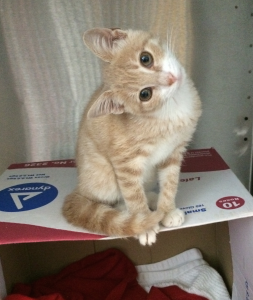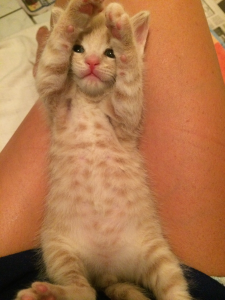The following is a guest post by Allison Cowen, DVM class of 2016 at Cornell University.
When people ask me what I’m doing this summer I tell them I am playing with kittens, professionally. While this is by no means 100% true, it comes closer than most jobs could. Let me explain.
At some point during my second year in veterinary school I approached Drs Berliner and Scarlett with a proposition: “I want to do research at the shelter. Can you help me?” We sat down for several meetings with some of the Maddie’s(R) shelter medicine crew and the brainstorming began. The goal was to find a project that was do-able in several months, would be interesting, but most importantly would be relevant and helpful to shelters.
 It was the second or third meeting when Dr. Berliner said “Wouldn’t it be nice to know how kittens grow in foster care and in shelters?” The answer was unequivocally “yes”, and so the idea was hatched, and we ran with it. I did a comprehensive literature review to see what information was out there regarding growth rates in shelter kittens and foster kittens. Nada. I looked for papers on disease occurrence and mortality in shelter kittens and foster kittens. Nada. In total, I found several papers that looked at these factors but only within environments that differ greatly from the shelter and foster environments, ie catteries, private homes, pathogen-free colonies, feral colonies, or in adult populations. But these are inherently very different situations.
It was the second or third meeting when Dr. Berliner said “Wouldn’t it be nice to know how kittens grow in foster care and in shelters?” The answer was unequivocally “yes”, and so the idea was hatched, and we ran with it. I did a comprehensive literature review to see what information was out there regarding growth rates in shelter kittens and foster kittens. Nada. I looked for papers on disease occurrence and mortality in shelter kittens and foster kittens. Nada. In total, I found several papers that looked at these factors but only within environments that differ greatly from the shelter and foster environments, ie catteries, private homes, pathogen-free colonies, feral colonies, or in adult populations. But these are inherently very different situations.
The orphaned malnourished kitten with snot coming out of its ears, eyes, nose and feet that was found in a drainpipe may grow at a very different rate from the purebred Siamese kitten in the cattery being sung to sleep every night. So it would be nice to know, is the universally accepted “1-pound per month” rule for kitten growth even relevant for kittens under these disadvantaged circumstances? What is normal for a hungry worm-filled kitten, and what is worrisome? Our hope for this study is that we will establish a normal rate of growth for kittens in these two very unique situations (shelter and foster care), and be able to use this information when monitoring the health of future kittens. We are also tracking disease occurrence as well as mortality in hopes of being able to draw correlations between some of these variables.
And so my career as a kitten snuggler began.
In actuality though, there is very little snuggling that goes on, as I do not want to become fomite-number-one. My days typically go like this: wake up, tend to whichever foster kittens I have at my home (including weighing them in what I have affectionately dubbed “the kitten cup”), head off to the shelter. I get out my data recording forms (every kitten gets its own form) and the kitten cup and work my way through the shelter kittens following these important steps:
- GLOVE UP
- Check to make sure I’ve got the ID number written down on the form matches the corresponding kitten (nothing worse than invalid data!)
- Pick up the kitten from the cage and try really, really hard not to snuggle it (by far the hardest part of my day)
- Place the kitten in the kitten cup, and jot down its weight
- Check its face for any ocular or nasal discharge
- Put kitten back
- Repeat all those steps for any kittens in the same cage
- Check its cage for stool quality, and also note how much they’ve eaten
- Take off gloves, spray down scale, and maybe even change scrub top if the kitten forced you to snuggle
 I do this for every kitten in the shelter every day that looks to be less than or around 8 weeks old. For the foster kittens, these responsibilities fall on the foster providers. Fortunately, Tompkins County SPCA has a really awesome and dedicated pool of foster parents, most of whom are more than happy to help with this and have been amazing about tracking each kitten’s weight, fecal quality, eating habits, and any disease and subsequent treatments. Much my day involves corresponding with the foster care providers, making sure things are going okay, and bringing them anything they may need – new forms, a scale, etc.
I do this for every kitten in the shelter every day that looks to be less than or around 8 weeks old. For the foster kittens, these responsibilities fall on the foster providers. Fortunately, Tompkins County SPCA has a really awesome and dedicated pool of foster parents, most of whom are more than happy to help with this and have been amazing about tracking each kitten’s weight, fecal quality, eating habits, and any disease and subsequent treatments. Much my day involves corresponding with the foster care providers, making sure things are going okay, and bringing them anything they may need – new forms, a scale, etc.
As someone who previously thought she was not a “research person” I can 100% tell anyone that whether or not you are a “research person” depends on what you are studying and whether or not you care. This has been an absolutely rewarding summer because I care about the project and am genuinely excited to see what our data holds. And of course a large part of what makes this project SO easy to care about is seeing the kittens day after day and knowing that these will be the beneficiaries of your research. I truly hope this information will be helpful in the future – helpful to shelter staff, to foster parents, to veterinarians, and most importantly to the kittens.
And lastly, a huge thank you to Drs Berliner and Scarlett, the Tompkins County SPCA staff, the dedicated foster parents, Maddie’s Fund, Morris Animal Foundation, and American Humane Association for making my summer wonderful.

